英国文学史及作品选读Chapter9
英国文学史及作品选读

英国文学史及作品选读
以下是英国文学史的主要时期和一些著名的作品选读:
中世纪文学(5世纪-1485年)
《贝奥武夫》:一部史诗,讲述亚瑟王时代的英雄故事。
《坎特伯雷故事集》:乔叟的作品,包含一组个性鲜明的故事,反映了中世纪社会的不同面貌。
文艺复兴时期(1485年-1660年)
《亨利五世》:莎士比亚的历史剧,描绘了亨利五世在百年战争中的英勇事迹。
《哈姆雷特》:莎士比亚的悲剧,探讨了复仇、疯狂和人性的复杂主题。
17世纪文学
《失乐园》:约翰·弥尔顿的史诗,描写了亚当和夏娃失去乐园的故事,探讨了人类的起源和自由意志的主题。
18世纪文学
《格列佛游记》:乔纳森·斯威夫特的作品,通过幽默和讽刺描绘了一个虚构的旅行故事,暗示了当时社会和政治的弊病。
浪漫主义时期(1798年-1837年)
《弃婴》:威廉·华兹华斯的诗集,以自然、个人感受和内心体验为主题,表达了对自然和人类情感的追求。
《雾都孤儿》:查尔斯·狄更斯的小说,描绘了贫困和社会不公的问题,以及主人公的成长和奋斗。
维多利亚时期(1837年-1901年)
《简·爱》:夏洛蒂·勃朗特的小说,讲述了一个普通女子经历的情感和成长故事。
《傲慢与偏见》:简·奥斯汀的小说,以幽默和机智揭示了当时社会的阶级和婚姻观念。
(完整word版)英国文学史及选读作者及作品
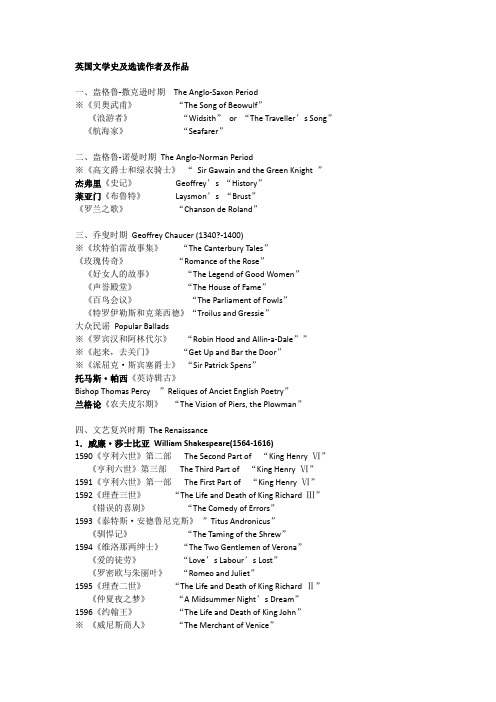
英国文学史及选读作者及作品一、盎格鲁-撒克逊时期The Anglo-Saxon Period※《贝奥武甫》“The Song of Beowulf”《浪游者》“Widsith”or “The Traveller’s Song”《航海家》“Seafarer”二、盎格鲁-诺曼时期The Anglo-Norman Period※《高文爵士和绿衣骑士》“Sir Gawain and the Green Knight ”杰弗里《史记》Geoffrey’s “History”莱亚门《布鲁特》Laysmon’s “Brust”《罗兰之歌》“Chanson de Roland”三、乔叟时期Geoffrey Chaucer (1340?-1400)※《坎特伯雷故事集》“The Canterbury Tales”《玫瑰传奇》“Romance of the Rose”《好女人的故事》“The Legend of Good Women”《声誉殿堂》“The House of Fame”《百鸟会议》“The Parliament of Fowls”《特罗伊勒斯和克莱西德》“Troilus and Gressie”大众民谣Popular Ballads※《罗宾汉和阿林代尔》“Robin Hood and Allin-a-Dale””※《起来,去关门》“Get Up and Bar the Door”※《派屈克·斯宾塞爵士》“Sir Patrick Spens”托马斯·帕西《英诗辑古》Bishop Thomas Percy ”Reliques of Anciet English Poetry”兰格论《农夫皮尔期》“The Vision of Piers, the Plowman”四、文艺复兴时期The Renaissance1.威廉·莎士比亚William Shakespeare(1564-1616)1590《亨利六世》第二部The Second Part of “King Henry Ⅵ”《亨利六世》第三部The Third Part of “King Henry Ⅵ”1591《亨利六世》第一部The First Part of “King Henry Ⅵ”1592《理查三世》“The Life and Death of King Richard Ⅲ”《错误的喜剧》“The Comedy of Errors”1593《泰特斯·安德鲁尼克斯》”Titus Andronicus”《驯悍记》“The Taming of the Shrew”1594《维洛那两绅士》“The Two Gentlemen of Verona”《爱的徒劳》“Love’s Labour’s Lost”《罗密欧与朱丽叶》“Romeo and Juliet”1595《理查二世》“The Life and Death of King Richard Ⅱ”《仲夏夜之梦》“A Midsummer Night’s Dream”1596《约翰王》“The Life and Death of King John”※《威尼斯商人》“The Merchant of Venice”1597《亨利四世》第一部The First Part of “King Henry Ⅳ”《亨利四世》第二部The Second Part of “King Henry Ⅳ”1598《无事生非》“Much Ado About Nothing”《温莎的风流娘儿们》”The Merry Wives of Windsor”《亨利五世》”The Life of King Henry Ⅴ”1599《尤利乌斯·凯撒》“The Life and Death of Julius Caesar”《皆大欢喜》”As You Like It”1600《第十二夜》“Twelfth Night ,or, What You Will”※1601《哈姆雷特》“Hamlet, Prince of Denmark”1602《特洛伊洛斯与克瑞西达》“Troilus and Cressida”《终成眷属》“All’s Well That Ends Well”1604《一报还一报》“Measure for Measure”《奥塞罗》“Othello, the Moore of Venice”1605《李尔王》”King Lear”《麦克白》“The Tragedy of Macbeth”1606《安东尼和克莉奥佩特拉》“Antony and Cleopatra”1607《科里奥拉鲁斯》”The Tragedy of Coriolanus”《雅典的泰门》“Timon of Athens”1608《佩里克利斯》“Pericles, Prince of Tyre”1609《辛白林》“Cymbeline, King of Britain”1610《冬天的故事》“The Winter’s Tale”《暴风雨》“The Tempest”《亨利八世》“The Life of King Henry Ⅷ”Poems《维纳斯与阿多尼斯》“Venus and Adonis”《露克丽丝受辱记》“Lucrece”※《十四行诗》“Sonnets”2。
英国文学简史及作品选读大纲目录
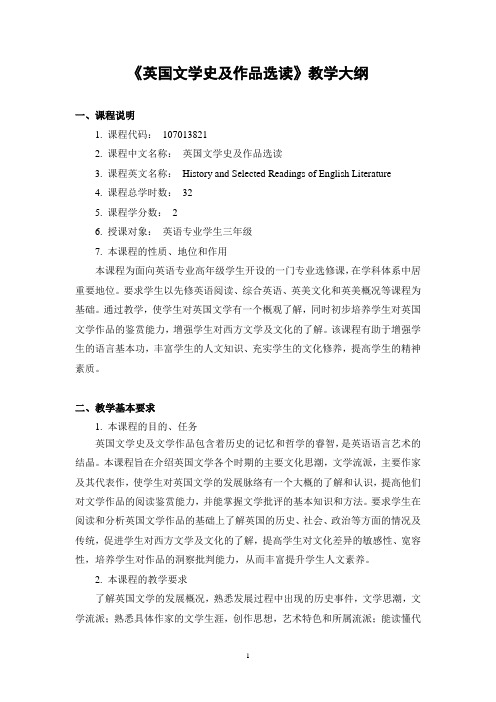
《英国文学史及作品选读》教学大纲一、课程说明1. 课程代码:1070138212. 课程中文名称:英国文学史及作品选读3. 课程英文名称:History and Selected Readings of English Literature4. 课程总学时数:325. 课程学分数:26. 授课对象:英语专业学生三年级7. 本课程的性质、地位和作用本课程为面向英语专业高年级学生开设的一门专业选修课,在学科体系中居重要地位。
要求学生以先修英语阅读、综合英语、英美文化和英美概况等课程为基础。
通过教学,使学生对英国文学有一个概观了解,同时初步培养学生对英国文学作品的鉴赏能力,增强学生对西方文学及文化的了解。
该课程有助于增强学生的语言基本功,丰富学生的人文知识、充实学生的文化修养,提高学生的精神素质。
二、教学基本要求1. 本课程的目的、任务英国文学史及文学作品包含着历史的记忆和哲学的睿智,是英语语言艺术的结晶。
本课程旨在介绍英国文学各个时期的主要文化思潮,文学流派,主要作家及其代表作,使学生对英国文学的发展脉络有一个大概的了解和认识,提高他们对文学作品的阅读鉴赏能力,并能掌握文学批评的基本知识和方法。
要求学生在阅读和分析英国文学作品的基础上了解英国的历史、社会、政治等方面的情况及传统,促进学生对西方文学及文化的了解,提高学生对文化差异的敏感性、宽容性,培养学生对作品的洞察批判能力,从而丰富提升学生人文素养。
2. 本课程的教学要求了解英国文学的发展概况,熟悉发展过程中出现的历史事件,文学思潮,文学流派;熟悉具体作家的文学生涯,创作思想,艺术特色和所属流派;能读懂代表作家的经典作品,并能分析评介作品的主题思想,人物形象,篇章结构、语言特点、修辞手法、文体风格;能掌握文学批评的基本知识和方法,对重要的文学术语有相当的了解并能在文学批评中加以运用。
本课程以代表作家的经典作品的主题思想、人物形象、文体风格、语言特点及其在文学史上的地位与影响为教学重点。
英国文学史及作品选读

英国文学史及作品选读英国文学史及作品选读英国文学是世界文学史上的重要组成部分之一,它源远流长,经历了漫长的历史发展过程。
早期的英国文学以诗歌、戏剧为主,随着时间的推移,小说和散文也渐渐兴起。
本文将介绍英国文学史的主要发展阶段和代表作品。
1. 古老的英国文学:史诗和传说英国文学的源头可以追溯到史前时代,当时的诗歌和传说通过口头传承流传了几个世纪。
直到公元七世纪左右,较早的英国文学作品才被记录下来。
这些作品包括《贝奥武夫》、《海顿和希格力》等史诗和传说。
其中,《贝奥武夫》是最有名的史诗之一,讲述了一个勇敢的勇士与恶龙的战斗故事。
它的作者是一位名叫“贝奥武夫”的盎格鲁-撒克逊战士,他用自己的生命保卫了他的国家。
这个故事反映了英雄主义、勇气和荣誉等价值观。
2. 中世纪的英国文学:中古诗歌和骑士文学中世纪的英国文学以中古诗歌和骑士文学为主,它们通常讲述骑士们与巨龙、独角兽等怪物的战斗,以及他们与公主的爱情故事。
其中最著名的作品是《坎特伯雷故事集》,由乔叟(Geoffrey Chaucer)创作,它是一部描绘中世纪人生活的作品,涵盖面广,内容丰富。
3. 文艺复兴时期的英国文学:诗歌和戏剧文艺复兴时期是英国文学发展的重要时期,以诗歌和戏剧为主。
这个时期的文学作品多以爱情、政治和社会问题为主题,反映了人们在这个时期的思想和价值观。
这个时期最著名的作品是莎士比亚(William Shakespeare)的剧作,如《哈姆雷特》、《罗密欧与朱丽叶》和《李尔王》等。
4. 18世纪和19世纪的英国文学:小说和诗歌18世纪和19世纪是英国文学发展的黄金时代,小说和诗歌成为主要文学形式。
18世纪的英国文学以浪漫主义为主题,以自然、感情和个性为核心,反映了人们对自然、感情和自我表达的追求。
例如,约翰·基茨(John Keats)的诗《仲夏夜之梦》向读者展示了自然的美丽和神秘性。
在19世纪,英国文学进一步发展,以托马斯·哈代(Thomas Hardy)和查尔斯·狄更斯(Charles Dickens)等作家为代表的小说也成为主要文学形式。
英国文学史及作品选读秋季学期 (秋季学期)
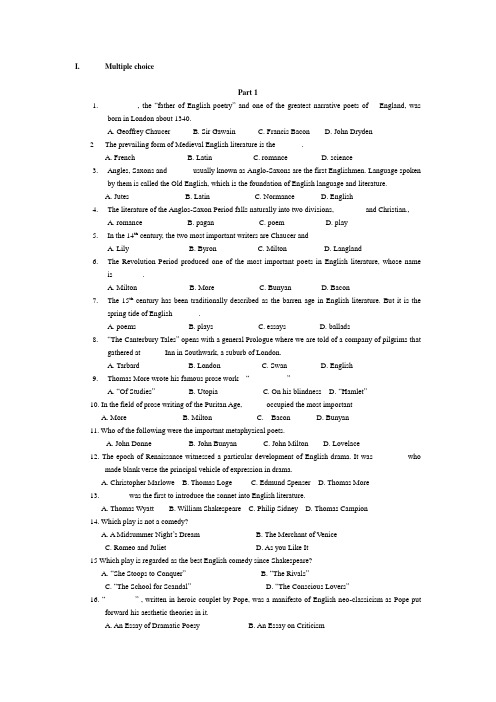
I.Multiple choicePart 11._______, the ―father of English poetry‖and one of the greatest narrative poets of England, wasborn in London about 1340.A. Geoffrey ChaucerB. Sir GawainC. Francis BaconD. John Dryden2 The prevailing form of Medieval English literature is the_______.A. FrenchB. LatinC. romanceD. science3.Angles, Saxons and ______ usually known as Anglo-Saxons are the first Englishmen. Language spokenby them is called the Old English, which is the foundation of English language and literature.A. JutesB. LatinC. NormanceD. English4.The literature of the Anglos-Saxon Period falls naturally into two divisions,________ and Christian.,A. romanceB. paganC. poemD. play5.In the 14th century, the two most important writers are Chaucer and ________A. LilyB. ByronC. MiltonD. Langland6.The Revolution Period produced one of the most important poets in English literature, whose nameis________.A. MiltonB. MoreC. BunyanD. Bacon7.The 15th century has been traditionally described as the barren age in English literature. But it is thespring tide of English_______.A. poemsB. playsC. essaysD. ballads8.―The Canterbury Tales‖ opens with a general Prologue where we are told of a company of pilgrims thatgathered at ______Inn in Southwark, a suburb of London.A. TarbardB. LondonC. SwanD. English9.Thomas More wrote his famous prose work ―__________‖A. ―Of Studies‖B. UtopiaC. On his blindnessD. ―Hamlet‖10. In the field of prose writing of the Puritan Age, ______occupied the most importantA. MoreB. MiltonC. BaconD. Bunyan11. Who of the following were the important metaphysical poets.A. John DonneB. John BunyanC. John MiltonD. Lovelace12. The epoch of Renaissance witnessed a particular development of English drama. It was ________ whomade blank verse the principal vehicle of expression in drama.A. Christopher MarloweB. Thomas LogeC. Edmund SpenserD. Thomas More13. _______ was the first to introduce the sonnet into English literature.A. Thomas WyattB. William ShakespeareC. Philip SidneyD. Thomas Campion14. Which play is not a comedy?A. A Midsummer Night’s DreamB. The Merchant of VeniceC. Romeo and JulietD. As you Like It15 Which play is regarded as the best English comedy since Shakespeare?A. ―She Stoops to Conquer‖B. ―The Rivals‖C. ―The School for Scandal‖D. ―The Conscious Lovers‖16. ―________‖ , written in heroic couplet by Pope, was a manifesto of English neo-classicism as Pope putforward his aesthetic theories in it.A. An Essay of Dramatic PoesyB. An Essay on CriticismC. The Advance of LearningD. An Essay on Man17. The 18th century witnessed that in England there appeared two political parties, the Whigs and the Tories,which were satirized by Swift in his ―________‖A. Gulliver’s TravelsB. A Tale of a TubC. The Battle of the BooksD. A Modest Proposal18. Thomas Gray’s masterpiece, ―__________‖once and for all established his fame as the leader of thesentimental poetry of the day, especially ―The Graveyard School‖A. Ode on the SpringB. Ode on a Distant Prospect of Eton CollegeC. Elegy Written in a Country ChurchyardD. Hymn to Adversity19 _______ was regarded as ―Father of the English Novel‖, for his contribution to the establishment of theform of the modern novel.A. Daniel DefoeB. Jonathan SwiftC. Jane AustenD. Henry Fielding20 .In the last twenty years of the 18th century England produced two great romantic poets. They are ______.A. Johnson and BlakeB. Gray and YoungC. Pope and GoldsmithD. Blake and BurnsKey to part 11.A2. C3. A4.B5.D6.A7.D8.A9. B 10. D 11.A 12.A. 13.A 14.C.15.C 16.B 17.A 18.C 19.D 20.D1.Chaucer died on the 25th of October 1400, and was buried in _______.A. FlandersB. FranceC. ItalyD. Westminster Abbey2.Angles, Saxons and Jutes usually know as Anglo-Saxons are the first Englishmen. Language spoken bythem is called the ______, which is the foundation of English language and literature.A. Old EnglishB. Modern EnglishC. Anglo EnglishD. Jute’s English3.The literature of the Anglos-Saxon Period falls naturally into two divisions,________ and Christian.,A. paganB. poetC. romanceD. novel4.The 15th century has been traditionally described as the barren age in English literature. But it is thespring tide of English_______.A. poemsB. playsC. essaysD. ballads5.Chaucer’s work ― _________‖ gives us a picture of the condition of English life of his day, such as itswork and play, its deeds and dreams, its fun and sympathy.A. ―The Canterbury Tales‖B. ―A Red ,Red Rose‖C. ―On His Blindness‖D. ―As You Like It‖6. In Elizabethan Period, _________wrote many excellent essays such as―Of Studies‖.A. John MiltonB. John LylyC. Thomas MoreD. Francis Bacon7.________is the greatest writer of the 17th century, and one of the giants of English literature.A. ShakespeareB. Thomas MoreC. John MiltonD. Bacon8. _______ was the most gifted of the university wits. He produced in allsix plays and several poems.A. John MiltonB. Thomas MoreC. Christopher MarloweD. Francis Bacon9. At the beginning of the 16th century the outstanding humanist _____wrote his ―Utopia‖ in which he gave a profound and truthful pictureof the people’s suffering and put forward his ideal of a future happy society.A. Thomas MoreB. Christopher MarloweC. Francis BaconD. Shakespeare10.English Renaissance Period was an age of ________.A. prose and novelB. poetry and dramaC. essays and journalsD. ballads and songs11.______ wrote his masterpiece ― The Pilgrim’s Progress‖ during hissecond imprisonment.A. John MiltonB. John BunyanC. Thomas MoreD. John Donne12.Most of the English writers in the 18th century were enlighteners. Theyfell into two groups, one is ______, and the other is____.A. the moderate group; the radical groupB. the passive Romantic poets; the active Romanic poetsC. the Metaphysical poets; the Cavalier poetsD. the lakers; the sentimentalists.13. _______ was regarded as ―Father of the English Novel‖, for his contributionto the establishment of the form of the modern novel.A. Daniel DefoeB. Jonathan SwiftC. Jane AustenD. Henry Fielding14._______ compiled the ―The Dictionary of the English language‖ whichbecame the foundation of all the subsequent English dictionaries.A. Ben JohnsonB. Samuel JohnsonC. Alexander PopeD. John Dryden15.Among the following which is Sheridan’s comedy?A. ―The Rivals‖ B ―She stoops to Conquer‖C. ―V olpone‖D. ―Everyone in His Humor‖16.Which two periodicals were Steele and Addison’s chief contribution toEnglish literature?A. ―The Tatler‖ and ―The Spectator‖B. ―The Rambler‖ and ―The Spectator‖C. ―The Tatler‖ and ―The Review‖D. ―The Spectator‖ and ―The Review‖17.__________ was Pope’s poem which satirized the idle and artificial life of the aristocracy.A. ―The Rape of the Lock‖B. ―The Rape of Lucrece‖C. ―The School for Scandal‖D. ―Everyone Man in His Humour‖18. Who was the greatest dramatist in the 18th century?A. GoldsmithB. SheridanC. SterneD. Fielding19Who of the following was the important metaphysical poet?A. John DonneB. John BunyanC. John MiltonD. Richard Lovelace20. ―Shall I compare thee to a summer’s day?‖ This is the beginning line of Shakespeare’s _______A. songB. playC. comedyD. sonnetPart 21.Generally speaking, Chaucer’s works fall into three main groups corresponding roughly to the threeperiods of his adult life. Which period is wrong?A.The period of French influence (1359-1372)B.The period of Italian influence (1372-1386)C.The period of English influence (1386-1400)D.The period of American influence (1371-1382)2.______, Saxons and Jutes usually known as Anglo-Saxons are the first Englishmen. Language spoken bythem is called the Old English, which is the foundation of English language and literature.A. NormanB. FrenchC. AnglesD. English3.The literature of the Anglos-Saxon Period falls naturally into two divisions,________ and Christian.A. poemB. playC. paganD. poetry4._________, the two most important writers are Chaucer and Langland.A. In the 13th centuryB. In the 14th centuryC. In the 15th centuryD. In the 16th century5.The 15th century has been traditionally described as the barren age in English literature. But it is thespring tide of English_______.A. balladsB. playsC. poemsD. essays6.In Elizabethan Period, _____wrote more than fifty excellent essays, which made him of the best essayistsin English literature.A.John MiltonB. Thomas MoreC. Francis BaconD. Robert Burns7. In the Revolution Period ________towers over his age as William Shakespeare towers over theElizabethan age and as Chaucer towers over the Medieval period.A. William BlakeB. Christopher MarloweC. John MiltonD. Thomas More8. In Milton’s works, ______is the greatest, indeed the only generally acknowledged epic in Englishliterature since ―Beowulf‖A. ―Paradise Lost‖B. ―Paradise Regained‖C. ―Samson Agonistes‖D. ―Lycidas‖9. _______ was the first to introduce the sonnet into English literature?A. Thomas WyattB. William ShakespeareC. Philip SidneyD. Thomas Canpion10. ______ is not the best representative of the English humanists in the Renaissance.A. Thomas MoreB. Christopher MarloweC. William ShakespeareD. Edmund Spenser11. ______is regarded as the pioneer of English drama.A. William ShakespeareB. Christopher MarloweC. Edmund SpenserD. John Donne12. English Renaissance Period was an age of _________.A. prose and novelB. poetry and dramaC. essays and journalsD. ballads and song10.______was regarded as ―Father of the English Novel‖, for his contribution to the establishment of theform of the modern level.A. Daniel DefoeB. Jonathan SwiftC. Henry FieldingD. Jane Austen14. English Renaissance Period was not an age of prose, but Thomas More wrote his famous prose work―________‖.A. UtopiaB. Robinson CrusoeC. Gulliver’s TravelsD. Of StudiesKeys to part 21.D2. C3.C4. B5. A6.C7. C8.A9. A 10. D 11. B 12.B 13C 14.APart 31. ______ is often referred to as ―the father of English poetry‖. .A. ShakespeareB. MiltonC. ChaucerD. Pope2. All the following famous writers were living in Elizabethan period except ___________ .A. ShakespeareB. MarloweC. PopeD. Jonson3. A _____ is a story told in song, usually in 4-line stanzas, with the second and the fourth lines rhymed.A. balladB. dramaC. novelD. sonnet4.The literature of the Anglos-Saxon Period falls naturally into two divisions,________ and Christian.,A. romanceB. paganC. poemD. play5.The Revolution Period produced one of the most important poet in English literature, whose nameis________.A. MiltonB. MoreC. BunyanD. Bacon6. The English language underwent a great change as a result of _____.A. the Norman ConquestB. RenaissanceC. the Roman ConquestD. the Danish invasion7. ―The Canterbury Tales‖ opens with a general Prologue where we are told of a company of pilgrims thatgathered at ______Inn in Southwark, a suburb of London.A. TabardB. LondonC. SwanD. English8. Thomas More wrote his famous prose work __________A. ―Of Studies‖B. ―Utopia‖C. ―On his blindness‖D. ―Hamlet‖9. Who of the following was the important metaphysical poet ?A. John DonneB. John BunyanC. John MiltonD. Lovelace10. ―_______‖ is the oldest poem in the English language, and also the oldest surviving epic in the Englishlanguage.A. BeowulfB. OdysseyC. King ArthurD. Illiad11. The epoch of Renaissance witnessed a particular development of Englishdrama. It was ______ who made blank verse the principal vehicle of expression in drama.A. Christopher MarloweB. Thomas LodgeC. Edmund SpenserD. Thomas More12. _______ was the first to introduce the sonnet into English literature.A. Thomas WyattB. William ShakespeareC. Philip SidneyD. Thomas Campion13. Apart from being a great ____, Bacon was the _____ of modern science .A. essayist, founderB. politician, discovererC. novelist, founderD. judge, advocate14. Which play is regarded as the best English comedy since Shakespeare?A. ―She Stoops to Conquer‖B. ―The Rivals‖C. ―The School for Scandal‖D. ―The Conscious Lovers‖15. ―________‖ , writt en in heroic couplet by Pope, was a manifesto of Englishneo-classicism as Pope put forward his aesthetic theories in it.A. An Essay of Dramatic PoesyB. An Essay on CriticismC. The Advance of LearningD. An Essay on Man16. The 18th century witnessed that in England there appeared two politicalparties, the Whigs and the Tories, which were satirized by Swift in his ____A.Gulliver’s TravelsB. A Tale of a TubC. The Battle of the BooksD. A Modest Proposal17. Thomas Gray’s masterpiece, ―__________‖ once and for all establishedhis fame as the leader of the sentimental poetry of the day, especially―The Graveyard School‖A. Ode on the SpringB. Ode on a Distant Prospect of Eton CollegeC. Elegy Written in a Country ChurchyardD. Hymn to Adversity18. _______ was regarded as ―Father of the English Novel‖, for his contribution to the establishment of theform of the modern novel.A. Daniel DefoeB. Jonathan SwiftC. Jane AustenD. Henry Fielding19. _____ is Milton’s masterpiece, which is ____ consisting of _____books.A. ―Paradise Regained‖, a play, 11B. ―Paradise Lost‖, an epic, 12C. ―Samson Agonistes‖, a poem, 13D. ―Lycidas‖, a lyric, 1020. ______ contributed many articles to the Tatler.A. AddisonB. PopeC. SwiftD. Milton21. The Neo-classical writers modeled themselves on _______ authors, and tried to control literary creationby ______.A. Elizabethan, blank verseB. Caroline, drama onlyC. ancient Greek and Roman, fixed lawsD. Jacobean, religion22. Who was the greatest dramatist in the 18th century?A. GoldsmithB. SheridanC. SterneD. Fielding23 ―Shall I compare thee to a summer’s day?‖ This is the beginning line of Shakespeare’s _______A. songB. playC. comedyD. sonnet24. The prevailing form of Medieval English literature is the ______.A. essayB. novelC. romanceD. drama25. Most of the English writers in the 18th century were enlighteners. They fell into two groups, one is ______,and the other is _____.A. the moderate group; the radical groupB. the passive Romantic poets; the active Romantic poetsC. the Metaphysical poets; the Cavalier poetsD. the lakers; the sentimentalistsKey to part 31—5 CCABA 6—10 AABAA 11—15 AAACB 16—20 ACDBA21—25 CBDCAPart 4( ) 1. A ballad is a story told in ____, usually in 4-line stanzas, with the ___ and the_____ lines rhymed.A. poetry, first, thirdB. drama, first, fourthC. song, second, fourthD. words, second, third( )2. Many words and terms came into the English language as a result of _____.A. the Norman ConquestB. RenaissanceC. the Roman ConquestD. the Danish invasion( )3. William Shakespeare was fortunate to be living in the ______ period.A. CarolineB. ElizabethanC. VictorianD. Jacobean( ) 4. ―The Canterbury Tales‖ was written in ___ period of Chaucer’s writing career.A. the firstB. the secondC. the third C. the fourth( ) 5. Chaucer is often referred to as ―the father of English poetry‖ because he_____ .A. was the first poet in EnglandB. was the poet laureate in his timeC. first used English in his poetryD. he introduced French form( ) 6. Apart from being a great ____, Bacon was the _____ of modern science .A. essayist, founderB. politician, discovererC. novelist, founderD. judge, advocate( ) 7. . ―Beowulf‖ has been considered the national _____ of the English people.A. symbolB. epicC. heroD. art( ) 8. The tragedy of Othello lies in his____ while that of Macbeth lies in his _____.A. hesitation, blindnessB. jealousy, burning ambitionC. ambition, hesitationD. blindness, jealousy( ) 9. _____ is Milton’s masterpiece, which is ____ consisting of _____books.A. ―Paradise Regained‖, a play, 11B. ―Paradise Lost‖, an epic, 12C. ―Samson Agonistes‖, a poem, 13D. ―Lycidas‖, a lyric, 10( ) 10. Addison started _____ which was a _____.A. ―The Spectator‖, daily paperB. ―The Tatler‖, periodicalC. ―Idler‖, maganizeD. ―Rambler‖, a weekly paper( ) 11. The Neo-classical writers modeled themselves on _______ authors, and tried to control literary creation by ______.A. Elizabethan, blank verseB. Caroline, drama onlyC. ancient Greek and Roman, fixed lawsD. Jacobean, religion( )12. _____ was the most important poet in the first half of the 18th century.A. S. JohnsonB. J. SwiftC. PopeD. R. Steele( ) 13. ―Essay on Criticism‖ is a _____ poem written in ______.A. didactic, heroic coupletsB. short, blank verseC. philosophical, sonnet formD. romantic, ballad form( ) 14. Johnson’s most important literary work is ______ .A. ―London‖B. ―The Vanity of Human Wishes‖C. ―Rassela‖D. ―Lives of Poets‖( )15. ______ marked the end of English writers reliance on the patronage of the rich and the powerful for support.A. Johnson and PopeB. Shakespeare and JonsonC. Addison and SteeleD. Milton and Shakespeare( ) 16. James Boswell today is chiefly known for his______.A. poetryB. novelC. essaysD. biography( ) 17. ―Areopagitica‖ is a very famous pamphlet by ______ .A. ChaucerB. MiltoC. ShakespeareD.Johnson( ) 18. During the Anglo-Norman period, the most important literary work being____.A. BeowulfB. OdysseyC. King ArthurD. Illiad( ) 19. Chaucer was greatly influenced by Boccaccio, author of ______ .A. sonnetsB. ―Decameron‖C. ―Divine Comedy‖D. ―Odyssey( ) 20. _____ is a very small country, yet it has produced many Nobel literature prize winners.A. EnglandB. FranceC. ItalyD. Ireland( )21. Another term for Old English is_______.A. Middle EnglishB. Anglo-SaxonC. DeutscheD. Welsh( ) 22. The Canterbury Tales includes stories by _______.A. each of the pilgrimsB. some of the pilgrimsC. Chaucer in the role of a pilgrimD. religious figures only( ) 23. The Renaissance came to England _______ .A. at about the same time it came to continental Europe.B. earlier than it came to continental EuropeC. later than it came to continental EuropeD. in 1457( ) 24. A powerful influence on the Renaissance was _______ .A. medieval Latin worksB. classical Latin and Greek worksC. native English writingsD. literature from the Orient( ) 25. In 1534, Henry VIII declared himself to be ________ .A. a loyal subject of the PopeB. a follower of Martin LutherC. head of the English ChurchD. an atheist( ) 26. Blank verse is _________ .A. unrhymed iambic pentameterB. rhymed iambic pentameterC. unrhymed iambic tetrameterD. rhymed iambic trimeter( ) 27. In which of these plays are women wrongly accused of infidelity?A. Much Ado About Nothing, OthelloB. King Lear, HamletC. A Winter’s Tale, The TempestD. Measure for Measure, The Taming of the Shrew( ) 28. The seventeenth Century witnessed the influence of all of the following social and intellectual forces except______ .A. PuritanismB. RationalismC. TranscendentalismD. the scientific spirit( ) 29. The King James Bible of 1611 is also known as __________ .A. the Coverdale BibleB. the VulgateC. the Vespasian PsalterD. the Authorized Version( ) 30. Paradise Lost is a poetic narration of __________ .A. the birth, death, and resurrection of JesusB. the events relating to the Garden of Eden and the banishment of SatanC. the Book of RevelationsD. the prophecies of JeremiahPart 41. C2. A3. B4. C5. C6. A7. B8. B9. B 10. B11. C12. C 13. A14. D15. A16. D17. B18. A19.B20.D21. B22. B 23. C 24. B25. C26. A27. A 28. C29. D30. BPart 57.Generally speaking, Chaucer’s works fall into three main groups corresponding roughly to thethree periods of his adult life. Which period is Not correct ?A.The period of American influence (1359-1372)B.The period of Italian influence (1372-1386)C.The period of English influence (1386-1400)D.The period of French influence (1371-1382)8. A ballad is a story told in ____, usually in 4-line stanzas, with the ___ andthe_____ lines rhymed.A. poetry, first, thirdB. drama, first, fourthC. songs, second, fourthD. words, second, third3. _________, the two most important writers were Chaucer and Langland.A. In the 13th centuryB. In the 14th centuryC. In the 15th centuryD. In the 16th century4.The 15th century has been traditionally described as the barren age in English literature. But it is thespring tide of English_______.A. balladsB. playsC. poemsD. essays5.In Elizabethan Period, _____wrote more than fifty excellent essays, which made him one of the bestessayists in English literature.A. John MiltonB. Thomas MoreC. Francis BaconD. Robert Burns6.The 18th century was an age of prose. A group of excellent prose writers, such as___________ were produced.A. More and BaconB. More and AddisonC. Addison and SteeleD. Bacon and Steele7. In the Revolution Period ________towers over his age as William Shakespeare towers over theElizabethan age and as Chaucer towers over the Medieval period.A. William BlakeB. Christopher MarloweC. John MiltonD. Thomas More8. ____________ written by Bunyan gives a vivid and satirical description of Vanity Fair which is thesymbol of London at the time of Restoration.A. The Pilgrim’s ProgressB. The Canterbury TalesC. Gulliver’s TravelsD. Robinson Crusoe9. _______ was the first to introduce the sonnet into English literature.A. Thomas WyattB. William ShakespeareC. Philip SidneyD. Thomas Canpion10. ______ is not the best representative of the English humanists in the Renaissance.A. Thomas MoreB. Christopher MarloweC. William ShakespeareD. Edmund Spenser11. ______is regarded as the pioneer of English drama.A. William ShakespeareB. Christopher MarloweC. Edmund SpenserD. John Donne12. English Renaissance Period was an age of _________.A. prose and novelB. poetry and dramaC. essays and journalsD. ballads and song13.______was regarded as ―Father of the English Novel‖, for his contribution to the establishment of theform of the modern level.A. Daniel DefoeB. Jonathan SwiftC. Henry FieldingD. Jane Austen14. English Renaissance Period was not an age of prose, but Thomas More wrote his famous prose work―________‖ during this period.A. UtopiaB. Robinson CrusoeC. Gulliver’s TravelsD. Of Studies15. Which play is not a comedy written by Shakespeare?A. A Midsummer Night’s DreamB. The Merchant of VeniceC. Romeo and JulietD. As You Like It16. Which play is regarded as the best English comedy since Shakespeare?A. ―She Stoops to Conquer‖B. ―The Rivals‖C. ―The School for Scandal‖D. ―The Conscious Lovers‖17. ―________‖, written in heroic couplet by Pope, was a manifestoof English neo-classicism as Pope put forward his aesthetic theories in it.A. An Essay of Dramatic PoesyB. An Essay on CriticismC. The Advance of LearningD. An Essay on Man18. The 18th century witnessed the appearance of two political parties in England, the Whigs and the Tories,which were satirized by Swift in his __________.A. Gulliver’s TravelsB. A Tale of a TubC. The Battle of the BooksD. A Modest Proposal19. ―___________‖is the oldest poem in the English language, and also the oldest surviving epic in theEnglish language.A. IliadB. SonnetC. BeowulfD. The Canterbury Tales20. In the last twenty years of the 18th century England produced two great romantic poets. They are ______.A. Johnson and BlakeB. Gray and YoungC. Pope and GoldsmithD. Blake and BurnsKey to Part 51.A2.C3.B 4 . A 5. C 6.C 7. C 8.A 9. A 10. D 11. B 12.B 13C 14.A 15.C 16.C 17.B 18.A 19.C 20.DPart 6( ) 1. A ballad is a story told in ____, usually in 4-line stanzas, with the ___ and the_____ lines rhymed.A. poetry, first, thirdB. drama, first, fourthC. song, second, fourthD. words, second, third( ) 2. Many words and terms came into the English language as a result of _____.A. the Norman ConquestB. RenaissanceC. the Roman ConquestD. the Danish invasion( ) 3. William Shakespeare was fortunate to be living in the ______ period.A. CarolineB. ElizabethanC. VictorianD. Jacobean( ) 4. ―The Canterbury Tales‖ was written in ___ period of Chaucer’s writing career.A. the firstB. the secondC. the thirdD. the fourth( ) 5. Chaucer is often referred to as ―the father of English poetry‖ because he_____ .A. was the first poet in EnglandB. was the poet laureate in his timeC. first used English in his poetryD. he introduced French form( ) 6. Apart from being a great ____, Bacon was the _____ of modern science.A. essayist, founderB. politician, discovererC. novelist, founderD. judge, advocate( ) 7. ―Beowulf‖ has been considered the national _____ of the English people.A. symbolB. epicC. heroD. art( ) 8. The tragedy of Othello lies in his____ while that of Macbeth lies in his _____.A. hesitation, blindnessB. jealousy, burning ambitionC. ambition, hesitationD. blindness, jealousy( ) 9. _____ is Milton’s masterpiece, which is ____ consisting of _____books.A. ―Paradise Regained‖, a play, 11B. ―Paradise Lost‖, an epic, 12C. ―Samson Agonistes‖, a poem, 13D. ―Lycidas‖, a lyric, 10( ) 10. Addison started _____ which was a _____.A. ―The Spectator‖, daily paperB. ―The Tatler‖, periodicalC. ―Idler‖, magazineD. ―Rambler‖, a weekly paper( ) 11. The Neo-classical writers modeled themselves on _______ authors, and tried to control literary creation by ______.A. Elizabethan, blank verseB. Caroline, drama onlyC. ancient Greek and Roman, fixed lawsD. Jacobean, religion( ) 12. _____ was the most important poet in the first half of the 18th century.A. S. JohnsonB. J. SwiftC. PopeD. R. Steele( ) 13. ―Essay on Criticism‖ is a _____ poem written in ______.A. didactic, heroic coupletB. short, blank verseC. philosophical, sonnet formD. romantic, ballad form( ) 14. Johnson’s most important literary work is ______.A. ―London‖B. ―The Vanity of Human Wishes‖。
英国文学史及选读
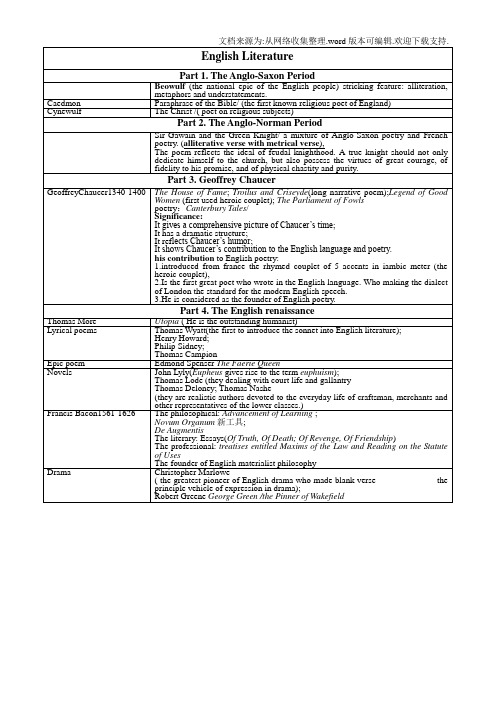
1.introduced from france the rhymed couplet of 5 accents in iambic meter (the heroic couplet),
2.Is the first great poet who wrote in the English language. Who making the dialect of London the standard for the modern English speech.
The professional:treatises entitled Maxims of the Law and Reading ontheStatute of Uses
The founder of English materialist philosophy
Drama
Christopher Marlowe
poetry:Canterbury Tales/
Significance:
It gives a comprehensive picture of Chaucer’s time;
It has a dramatic structure;
It reflects Chaucer’s humor;
It shows Chaucer’s contribution to the English language and poetry.
( the greatest pioneer of English drama who made blank versethe principle vehicle of expression in drama);
外研社英国文学史及选读(第二版)第二册教学课件Chapter 9 Thomas Hood
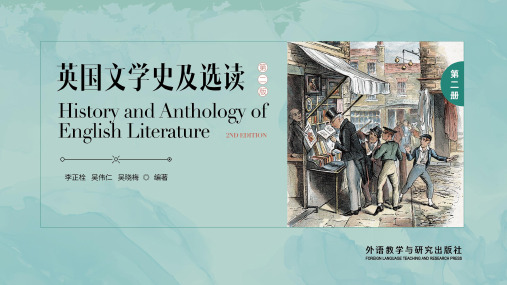
In poverty, hunger, and dirt,
And still with a voice of dolorous pitch,
95
Would that its tone could reach the rich!
She sang this “Song of the Shirt!”
Chapter 9 Thomas Hood
Part VII The First Half of the 19th Century: The Romantic Period
Part 1
Chapter 9 Thomas Hood
• 正文
Life and Works
Brief Comment
Selections
---Notes
---For Study and Discussion
Thank you
Chapter 9 Thomas Hood
Brief Comment
On this serious and perhaps cruel issue, he wrote humorously: “Don’t go to weep upon my grave, / And think that there I be. / They haven’t left an atom there / Of my anatomie.” Hood’s most widely-known work during his lifetime was “The Song of the Shirt”, which was a lament for a poor London seamstress who had been compelled to sell shirts she had made in order to feed her malnourished and ailing child. This poem appeared in one of the very first editions of Punch in 1843 and quickly became a public sensation, being turned into a popular song and inspiring social activists in defense of the countless labouring women who lived in abject poverty despite their constant industriousness.
英国文学选读--复习资料-罗经国
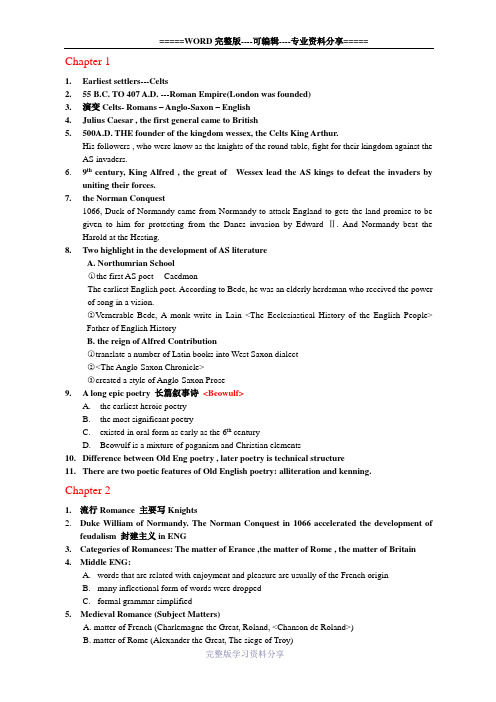
Chapter 11.Earliest settlers---Celts2.55 B.C. TO 407 A.D. ---Roman Empire(London was founded)3.演变Celts- Romans – Anglo-Saxon – English4.Julius Caesar , the first general came to British5.500A.D. THE founder of the kingdom wessex, the Celts King Arthur.His followers , who were know as the knights of the round table, fight for their kingdom against the AS invaders.6.9th century, King Alfred , the great of Wessex lead the AS kings to defeat the invaders byuniting their forces.7.the Norman Conquest1066, Duck of Normandy came from Normandy to attack England to gets the land promise to be given to him for protecting from the Danes invasion by Edward Ⅱ. And Normandy beat the Harold at the Hesting.8.Two highlight in the development of AS literatureA. Northumrian School○1the first AS poet ---CaedmonThe earliest English poet. According to Bede, he was an elderly herdsman who received the power of song in a vision.○2Vernerable Bede, A monk write in Lain <The Ecclesiastical History of the English People> Father of English HistoryB. the reign of Alfred Contribution○1translate a number of Latin books into West Saxon dialect○2<The Anglo-Saxon Chronicle>○3created a style of Anglo-Saxon Prose9. A long epic poetry 长篇叙事诗<Beowulf>A.the earliest heroic poetryB.the most significant poetryC.existed in oral form as early as the 6th centuryD.Beowulf is a mixture of paganism and Christian elements10.Difference between Old Eng poetry , later poetry is technical structure11.There are two poetic features of Old English poetry: alliteration and kenning.Chapter 21.流行Romance 主要写Knights2.Duke William of Normandy. The Norman Conquest in 1066 accelerated the development offeudalism 封建主义in ENG3.Categories of Romances: The matter of Erance ,the matter of Rome , the matter of Britain4.Middle ENG:A.words that are related with enjoyment and pleasure are usually of the French originB.many inflectional form of words were droppedC.formal grammar simplified5. Medieval Romance (Subject Matters)A. matter of French (Charlemagne the Great, Roland, <Chanson de Roland>)B. matter of Rome (Alexander the Great, The siege of Troy)C. Britain the Arthurian LegendBy Sir Gawain, Launce lot, Marlin, the quest for Holy Grail, the Death of King Arthur. Chapter 3 Age of Chaucer1.The Hundreds’Years War is an awakening of national Consciousness in ENG,the Frenchheroine Joan of Arc贞德2.Geoffrey Chaucer (Buried in the Poets’ Conner in Westminster Abbey)A.Father of Eng poetryB.The work of Geoffrey Chaucer○1influenced by French literature<The Book of the Duchess>○2influenced by Boccaccio <Travius and Cryseyde>○3<The Canterbury Tales >坎特伯雷故事集The general prologue 总序is the best part of it.3.the significances of <The Canterbury Tales>A.Gives a comprehensive picture of Chaucer’s timeB.The dramatic structure of the poem has been highly commended 高度赞赏by criticsC.Geoffrey Chaucer’s humorD.Chaucer’s contribution to ENG languageE.Perhaps the greatest work in Middle English4.John WycliffA.father of ENG proseB.one of the first figures who demanded to reform churchC.the one translate Bible into standard ENG5.William Langland<Sir Gawain> <Green Knights><The Vision of Piers Plowman> Chapter 41.main eventsA.The war of the Rose ,the thirty Years War(the house of Lancaster/Red, the house of York)B.The discovery of American and the new sea routesC.Reformation of church. HenryⅧfound the Anglican Church, break away from the church ofRome.2.Ballad: a narrative poem that tells a story3.Characters of BalladsA.the beginning is often abruptB.have strong dramatic elementsC.the story is told through dialogue and actionD.the theme is often tragicE.the meter格律is used (contains four-line stanzas, the odd numbered line奇数four feet, theeven numbered line偶数three feet. Rhymes fall on the even numbered lines.)4.BalladsA.<Robin Hood> A legendary hero living during the reign of Richard the Lion Heated 金雀花王朝B.<The Death of King Arthur>By Sir Thomas Mallory prefect the king Arthur5.Early ENG Plays(the 14th )developed into(mystery Plays神秘剧,miracle plays 奇迹剧)6.The flourishing of dramathe reason: no other entertainment ,both rich and poor can go to there英国文学史上三次高潮15th ENG Renaissance—19th上Romantic —19th下Victoria1.The BackgroundQueen Elizabeth , defeat the Spanish Armada 无敌舰队, mighty naval power强有力的海军.2.Humanism 人文主义Rebirth(文艺复兴的时代精神)Humanism Renaissance is a French word which means “rebirth ” in ENG3.人文主义的解释及价值观According to the Humanist scholars it was against human nature to ○1sacrifice the happiness of the life for an after life. They argued that ○2man should be given full freedom to enrich their intellectual and emotional life. In religion they demanded the reformation of the church, In art and literati on, instead of happiness in his life. Humanism shattered the shackles of spiritual bondage of man’s mind by the Roman catholic church and opened his eyes to “a brave new world” in front of him.4.Edmund Spenser <The Faerie Queen>5.The University WitsA.Robert GreeneB.Thomas Kyd <The Spanish Tragedy>C.Christopher Marlowe<The tragic History of Doctor Faustus> The blank Verse无韵诗Unrhymed iambic pentameter6.William ShakespeareA.发展○1Early years of his apprenticeship学徒期○2Growth and development○3gloom and depression○4restored serenityB.achievement○1represented the trend of history in giving write to the desires and aspiration of people○2S’ humanism: He had firm belief in the mobility of human nature and in the power of love○3S’ characterization, S’ characters are round 丰满的而非flatter 扁平○4originality○5as a great poet in sonnets○6master of the Eng language7.Four Tragedy : Hamlet, Othello, King Lear, The Tragedy of Macbeth8.Sonnets (Italy/Petrarch’s —the first one, S’s)A.definition A short song in the original meaning of the word become a poet of 14 lines.Usually in iambic pentameter抑扬格五音步with various rhyming schemes.B.Sonnet, 3 quatrains, 1 couplet (Shakespeare’s <Mr.W.H><Dark Lady>)9.S’s sonnets are different from Petrach’s.Petrach’s sonnets is divided into an octave(八音) which typically rhymes abba abba , and a sestet, which may have varying rhyme schemes.Shakespeare’s sonnets (English sonnets)consists of 3 quatrains and 1 couplet ,which typically rhyme abab cdcd efef gg .ends with a surprised conclusion or a shift of ideas.Petrach abba abba / cde cdeShakespeare abab cdcd efef / gg10.Hamlet —Humanist (melancholy忧郁procrastination优柔寡断)From Age of Elizabeth to Glorious Revolution1.Background(the ENG bourgeois revolution 资产阶级革命,农民与贵族阶级,Anglican church与Puritanical Church)2.Glorious Revolution 1688In 1688, William signed <The Bill of Rights> presented by Parliament, which greatly restricted the power of English King hence four ENGLAND has become a country of constitutional monarchy.君主立宪制3.The King James Bible of 1611Old Testament in HebrewsNew Testament in GreekThe earliest English translations of the Bible date back to Caedmon, Bade and King Alfred.4.Francis Bacon. Praised by Marx as “the pioneer of Eng Materialism唯心主义”5.<Of Studies>目的:Studies serve for delight, for ornament, for ability.功效:History make man wise; poetry witly; mathematics subtitle; natural philosophy deep; moral grave; logic and rhetoric able to contend.方法:Books are able to be tasked, others to be swallowed, and some few to be chewed and digested.6.玄学派特点(Metaphysical Poets)John DonneMetaphysical Poets describe a school of highly intellectual poetry marked by hold and ingenious conceits (奇思妙喻)incongruous imagery. Complexity of thought, frequent use of Paradox, and often by deliberate harshness or rigidity of expression.7.Main theme of Metaphysical Poets: love, death and religionMain theme of Cavalier(骑士派):Carpe Diem及时行乐8.Cavalier: Carpe diem<AValediction:forbidding mourning >A breach, but an expansionLike gold to airy thinness beatIf they be two, they are two so.As stiff twin compasses are two.THEME, 他人物质化的爱情与我柏拉图式的真爱。
(完整word版)英国文学史及选读作者及作品(word文档良心出品)
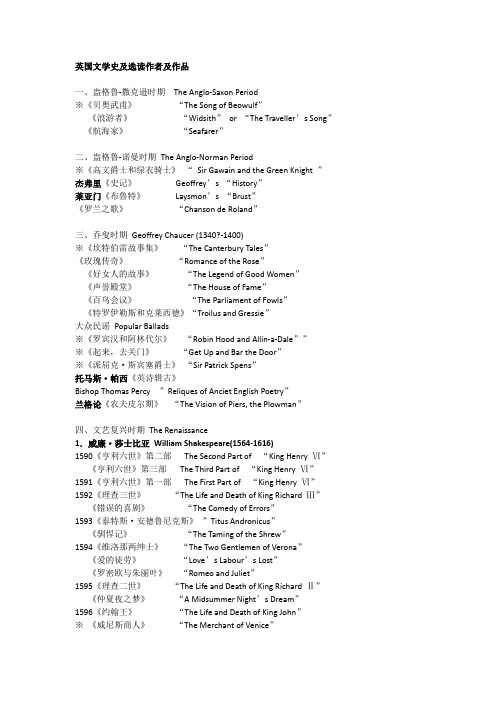
英国文学史及选读作者及作品一、盎格鲁-撒克逊时期The Anglo-Saxon Period※《贝奥武甫》“The Song of Beowulf”《浪游者》“Widsith”or “The Traveller’s Song”《航海家》“Seafarer”二、盎格鲁-诺曼时期The Anglo-Norman Period※《高文爵士和绿衣骑士》“Sir Gawain and the Green Knight ”杰弗里《史记》Geoffrey’s “History”莱亚门《布鲁特》Laysmon’s “Brust”《罗兰之歌》“Chanson de Roland”三、乔叟时期Geoffrey Chaucer (1340?-1400)※《坎特伯雷故事集》“The Canterbury Tales”《玫瑰传奇》“Romance of the Rose”《好女人的故事》“The Legend of Good Women”《声誉殿堂》“The House of Fame”《百鸟会议》“The Parliament of Fowls”《特罗伊勒斯和克莱西德》“Troilus and Gressie”大众民谣Popular Ballads※《罗宾汉和阿林代尔》“Robin Hood and Allin-a-Dale””※《起来,去关门》“Get Up and Bar the Door”※《派屈克·斯宾塞爵士》“Sir Patrick Spens”托马斯·帕西《英诗辑古》Bishop Thomas Percy ”Reliques of Anciet English Poetry”兰格论《农夫皮尔期》“The Vision of Piers, the Plowman”四、文艺复兴时期The Renaissance1.威廉·莎士比亚William Shakespeare(1564-1616)1590《亨利六世》第二部The Second Part of “King Henry Ⅵ”《亨利六世》第三部The Third Part of “King Henry Ⅵ”1591《亨利六世》第一部The First Part of “King Henry Ⅵ”1592《理查三世》“The Life and Death of King Richard Ⅲ”《错误的喜剧》“The Comedy of Errors”1593《泰特斯·安德鲁尼克斯》”Titus Andronicus”《驯悍记》“The Taming of the Shrew”1594《维洛那两绅士》“The Two Gentlemen of Verona”《爱的徒劳》“Love’s Labour’s Lost”《罗密欧与朱丽叶》“Romeo and Juliet”1595《理查二世》“The Life and Death of King Richard Ⅱ”《仲夏夜之梦》“A Midsummer Night’s Dream”1596《约翰王》“The Life and Death of King John”※《威尼斯商人》“The Merchant of Venice”1597《亨利四世》第一部The First Part of “King Henry Ⅳ”《亨利四世》第二部The Second Part of “King Henry Ⅳ”1598《无事生非》“Much Ado About Nothing”《温莎的风流娘儿们》”The Merry Wives of Windsor”《亨利五世》”The Life of King Henry Ⅴ”1599《尤利乌斯·凯撒》“The Life and Death of Julius Caesar”《皆大欢喜》”As You Like It”1600《第十二夜》“Twelfth Night ,or, What You Will”※1601《哈姆雷特》“Hamlet, Prince of Denmark”1602《特洛伊洛斯与克瑞西达》“Troilus and Cressida”《终成眷属》“All’s Well That Ends Well”1604《一报还一报》“Measure for Measure”《奥塞罗》“Othello, the Moore of Venice”1605《李尔王》”King Lear”《麦克白》“The Tragedy of Macbeth”1606《安东尼和克莉奥佩特拉》“Antony and Cleopatra”1607《科里奥拉鲁斯》”The Tragedy of Coriolanus”《雅典的泰门》“Timon of Athens”1608《佩里克利斯》“Pericles, Prince of Tyre”1609《辛白林》“Cymbeline, King of Britain”1610《冬天的故事》“The Winter’s Tale”《暴风雨》“The Tempest”《亨利八世》“The Life of King Henry Ⅷ”Poems《维纳斯与阿多尼斯》“Venus and Adonis”《露克丽丝受辱记》“Lucrece”※《十四行诗》“Sonnets”2。
《英国文学史及选读》教学大纲

《英国(yīnɡɡuó)文学史及选读》教学大纲课程(kèchéng)编码:071202总学时数:144一、课程性质、目的(mùdì)和要求通过(tōngguò)对英国文学史及选读的重点作家、作品的系统学习,学生应达到(dá dào)下列要求1.初步获得英国文学史的基础知识,掌握各历史时期文学发展的概况及特征,对有代表性作家的重要作品的思想性和艺术性有初步了解。
2.通过对各历史时期代表作家重要作品片段的学习,对各时期的文学思潮、流派及主要作家的写作风格和语言艺术有初步了解,从而提高对英语文学作品的鉴赏力,提高语言水平,更好地完成中学英语教育任务。
3.能以马列主义文艺理论的基本观点分析和评价作家和作品。
二、教学内容、要点与课时安排1.文艺复兴时期的文学。
2.十八世纪现实主义小说。
3.浪漫主义诗歌。
4.十九世纪批判现实主义小说。
5.现代主义文学。
本课程在第一学年开设,第一学期18周,每周4课时,第二学期18周,每周4课时,总计144课时。
各章节的教学内容、要点安排和具体课时安排如下:第一学期 72课时第一章古英语和中古时期的英国文学 12课时教学主题:古英语和中古时期的英国文学教学要点:盎格鲁—撒克逊时期的文学特征;英雄史诗Beowulf的故事(gùshì)内容和诗体特征。
1.盎格鲁—诺曼时期的文学特征;骑士文学的发展(fāzhǎn)概况,主题和类别;骑士故事(gùshì)“Sir Gawain and Green Knight”的故事(gùshì)内容。
2.十四世纪英国文学概况(gàikuàng);William Langland的长诗“Piers thePlowman”的思想内容及其社会意义; Geoffrey Chaucer的文学成就;乔叟的代表作The Canterbury Tales的内容简介和社会意义;学习The Canterbury Tales中的片段。
英国文学史及作品选读 Chapter 10

2011-6-19
1
1. Modernism:
The twentieth century was marked by the two World Wars, the direct result of the conflicts between rival imperialist countries and their ambition to dominate the world. Roughly speaking, the development of English literature in the twentieth century can be divided into two stages, that is , literature between WWI and WWII and literature after WWII.
2011-6-19 5
2. Angry Young Men
A phrase loosely applied to a number of British playwrights and novelists from the mid-1950s,whose political views were radical or anarchic, and who described various forms of social alienation. It is sometimes said to derive from the title of a work by the Irish writer Leslie Paul, Angry Young Man (1951). John Osborne: Look Back in Anger (1956);
英国文学史及作品选读 Chapter 9
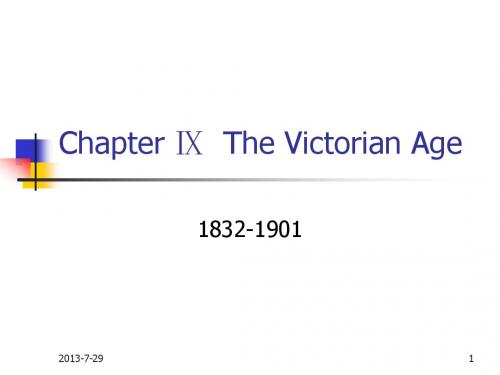
(1) (2)
(3)
7-29
2
2. The Victorian Poets
Lord Alfred Tennyson (1809-1892); Robert Browning (1812-1889); Matthew Arnold (1822-1888)
2013-7-29
3
2.1 Lord Alfred Tennyson
3. The Victorian novelists:
Charles Dickens William Makepeace Thackeray Emily Bronte Thomas Hardy Oscar Wilde
2013-7-29
6
3.1 Charles Dickens (1812-1870):
12
2013-7-29
4. The Victorian Playwright
George Bernard Shaw: The dramatic conflict in his plays is the conflict of thought and belief, Discussion is the basis of the plays, Shaw proves that mental and moral passion could produce absorbing dramatic material.
9
2013-7-29
3.3 The Bronte Sisters
Emily Bronte: Wuthering Heights Emily’s only novel, which was published in December of 1847 under the pseudonym Ellis Bell. It did not gain immediate success, Emily Brontëdied of tuberculosis a year after Wuthering Heights was published, on December 19, 1848, Theme: Race/Class/Education ; Revenge; Supernatural
英国文学史及作品选读(09级) Lecture 9

Lecture 9The Romantic Period (III)ⅠT eaching ContentJane Austen; Pride and PrejudiceⅡTime Allotment2 periodsⅢT eaching Objectives and Requirements1 Help the students have a good understanding of Jane Austen.2 Help the students have a good understanding of Pride and Prejudice, especiallyits first chapter.ⅣKey Points and Difficult Points in Teaching1Jane Austen2 Pride and PrejudiceⅤT eaching Methods and MeansLecture; Discussion; Multi-mediaⅥT eaching Process1 Jane Austen (1775-1817)1.1 Bibliographical introduction●Jane Austen was born in 1775 at Steventon, Hampshire. She was the youngerdaughter and the seventh child of a family of eight children. Austen briefly attended boarding school in Oxford, Southampton and Reading.●From the age of ten, her education was taken by her elder brothers and her father.Austen lived at uneventful life, passing the great part of it at her birth place and at Kent.●Her development as a novelist was slow and painstaking. She started writingnovels at about twenty, but each of them underwent revision and none was published at once.●Of her eight novels, only four appeared in her lifetime: Sense and Sensibility(1811), Pride and Prejudice(1813), Mansfield Park(1814) and Emma(1815).Northanger Abbey and Persuasion came out after her death. And the other two novels were left unfinished. On 18 July, 1817, at the age of forty-two, she died in her sister’s arms in Winchester.1.2 Comments on Austen●Jane Austen is a writer of the eighteenth century, though she lives in the nineteenthcentury England. She holds the ideal of the landlord class in politics, religion and moral principles; and her works show clearly her firm belief in the predominanceof reason over passion, the sense of responsibility, good manners and clear-sighted judgment. And in style, she is a neoclassicism advocator, upholding those traditional ideas of order, reason, proportion and gracefulness in novel writing.●Austen’s work has a very narrow literary field.◆The subject matter, the character range, the social setting, and plots are allrestricted to the provincial life of the late 18th century England, concerning three or four landed gentry families with their routine life.◆With trenchant observation and in meticulous detail, she presents the quiet,day-to-day life of the upper-middle-class English. She is particularly preoccupied with the relationship between men and women in love.◆Stories of love and marriage provide the major themes in all her novels, inwhich all characters are always playing an active part. In their pursuit of a marriage, they are usually categorized into three types according to their different attitudes: those who would marry for material wealth and social position, those who would marry just for beauty and passion, and those who would marry for true love with a consideration of the partner’s merit as well as his economical and social status. In another word, Austen tries to say that it is wrong to marry just for money or for beauty, but it is also wrong to marry without it.● Her novels show a wealth of humor, wit and delicate satire, as can be seen from hercharacterization of Mr. Bennet in Pride and Prejudice.●Her style is easy and effortless, a perfect example of what De Quincey (Englishessayist and critic, best-known for his autobiography Confessions of an English Opium Eater《一个英国鸦片服用者的自白》。
英国文学史期末复习重点
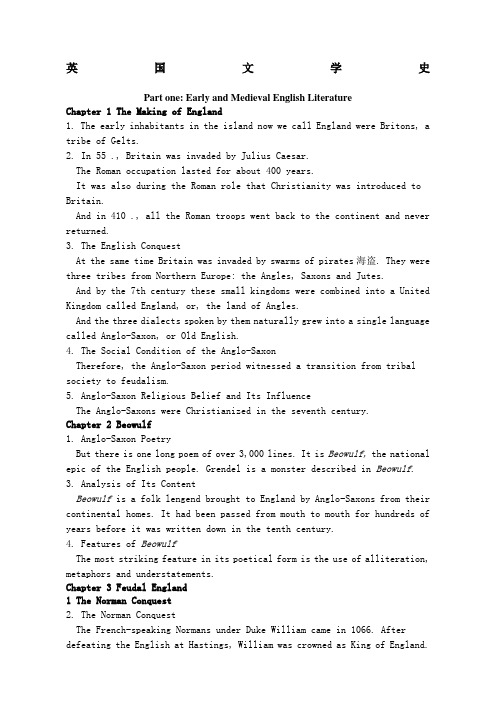
英国文学史Part one: Early and Medieval English LiteratureChapter 1 The Making of England1. The early inhabitants in the island now we call England were Britons, a tribe of Gelts.2. In 55 ., Britain was invaded by Julius Caesar.The Roman occupation lasted for about 400 years.It was also during the Roman role that Christianity was introduced to Britain.And in 410 ., all the Roman troops went back to the continent and never returned.3. The English ConquestAt the same time Britain was invaded by swarms of pirates海盗. They were three tribes from Northern Europe: the Angles, Saxons and Jutes.And by the 7th century these small kingdoms were combined into a United Kingdom called England, or, the land of Angles.And the three dialects spoken by them naturally grew into a single language called Anglo-Saxon, or Old English.4. The Social Condition of the Anglo-SaxonTherefore, the Anglo-Saxon period witnessed a transition from tribal society to feudalism.5. Anglo-Saxon Religious Belief and Its InfluenceThe Anglo-Saxons were Christianized in the seventh century.Chapter 2 Beowulf1. Anglo-Saxon PoetryBut there is one long poem of over 3,000 lines. It is Beowulf, the national epic of the English people. Grendel is a monster described in Beowulf.3. Analysis of Its ContentBeowulf is a folk lengend brought to England by Anglo-Saxons from their continental homes. It had been passed from mouth to mouth for hundreds of years before it was written down in the tenth century.4. Features of BeowulfThe most striking feature in its poetical form is the use of alliteration, metaphors and understatements.Chapter 3 Feudal England1 The Norman Conquest2. The Norman ConquestThe French-speaking Normans under Duke William came in 1066. After defeating the English at Hastings, William was crowned as King of England.The Norman Conquest marks the establishment of feudalism in England.3. The Influence of the Norman Conquest on the English LanguageBy the end of the fourteenth century, when Normans and English intermingled, English was once more the dominant speech in the country.3 The Romance1. The Content of the RomanceThe most prevailing kind of literature in feudal England was the romance.4. Malory’s Le Morte D’ArthurThe adventures of the Knights of the Round Table at Arthur’s court Chapter 5 The English Ballads2. The BalladsThe most important department of English folk literature is the ballad.A ballad is a story told in song, usually in 4-line stanzas, with the second and fourth lines rhymed.Of paramount importance are the ballads of Robin Hood.3. The Robin Hood BalladsChapter 6 Chaucer1. LifeGeoffrey Chaucer, the founder/father of English poetry.3. Troilus and CriseydeTroilus and Criseyde is Chaucer’s longest complete poem and his greatest artistic achievement.But the poet shows some sympathy for her, hitting that her fault springs from weakness rather than baseness of character.4. The Canterbury TalesThe Canterbury Tales is Chaucer’s masterpiece and one of the monumental works in English literature.6. His LanguageChaucer’s language, now called Middle English, is vivid and exact. Chaucer’s contribution to English poetry lies chiefly in the fact that he introduced from France the rhymed stanza of various types, especially the rhymed couplet of 5 accents in iambic meter the “the heroic couplet” to English poetry, instead of the old Anglo-Saxon alliterative verse.The spoken English of the time consisted of several dialects, and Chaucer did much in making dialect of London the standard for the modern English speech.Part Two: The English RenaissanceChapter 1 Old England in Transition1. The New MonarchyThe century and a half following the death of Chaucer was full of great changes.And Henry 7, taking advantage of this situation, founded the Tudor dynasty, a centralized monarchy of a totally new type, which met the needs of the rising bourgeoisie and so won its support.2. The ReformationProtestantismThe bloody religious persecution came to a stop after the church settlement of Queen Elizabeth.3. The English BibleWilliam TyndallThen appeared the Authorized Version, which was made in 1611 under the auspices of James I and so was sometimes called the King James Bible.The result is a monument of English language and English literature.The standard modern English has been fixed and confirmed.4. The Enclosure Movement5. The Commercial ExpansionChapter 2 More1. LifeThomas More2. UtopiaUtopia is More’s masterpiece, written in the form of a conversation between More and Hythlody, a returned voyager.The name “Utopia” comes from two Greek words meaning “no place”.3. Utopia, Book OneBook One of Utopia is a picture of contemporary England with forcible exposure of the poverty among the laboring classes.4. Utopia, Book TwoIn Book Two we have a sketch of an ideal commonwealth in some unknown ocean, where property is held in common and there is no poverty.Chapter 3 The Flowering of English Literature3. Edmund Spenser1 LifeThe Poet’s Poet of the period was Edmund Spenser.In 1579 he wrote The Shepher’s Calendar, a pastoral poem in twelve books, one for each month of the year.2 The Faerie Queene masterpieceSpenser’s greatest work, The Faerie Queene published in 1589-1596, is a long poem planned in 12 books, of which he finished only 6.iambic feet Spenserian Stanza4. Francis Bacon father/founder of English essaythe founder of English English materialist philosophyBacon is also famous for his Essays. When it included 58 essays.Bacon is the first English essayist.Chapter 4 Drama7. The PlaywrightsThere was a group of so-called “university wits” Lyly, Peele, Marlowe, Greene, Lodge and Nash.Chapter 5 Marlowe1. LifeThe most gifted of the “university wits” was Christopher Marlowe.2. WorkMarlowe’s best includes three of his plays, Tamburlaine,The Jew of Malta and Doctor Faustus.3. Doctor FaustusMarl owe’s masterpiece is The Tragical History of Doctor Faustus.5. Marlowe’s Literary AchievementMarlowe was the greatest of the pioneers of English drama.It is Marlowe who first made blank verse rhymeless iambic pentameter the principal instrument of English drama.Chapter 6 Shakespeare1. LifeWilliam Shakespeare was born on April 23, 1564, in Stratford-on-Avon.After his death, two of his above-mentioned fellow-actors, Herminge and Condell, collected and published Shakespeare’s plays in 1623. To this edition, which has been known as the First Folio.4. The Great ComediesA Midsummer Night’s Dream, The Merchant of Venice, As You Like It and Twelfth Night have been called Shakespeare’s “great comedies”.6. The Great TragediesShakespeare created his great tragedies, Hamlet, Othello, King Lear and Macbeth.7. Hamletthe son of the Renaissance9. The Poems1 Venus and Adonis2 The Rape of Lucrece3 Shakespeare’s Sonnets10. Features of Shakespeare’s DramaShakespeare and the Authorized Version of the English Bible are the two greatest treasuries of the English language.Shakespeare has been universally acknowledged to be the summit of the English Renaissance.Part Three: The Period of the English Bourgeois RevolutionChapter 1 The English Revolution and the Restoration5. The Bourgeois Dictatorship and the Restorationin 1688 Glorious Revolution6. The Religious Cloak of the English RevolutionPuritanism was the religious doctrine of the revolutionary bourgeoisie during the English Revolution. It preached thrift, sobriety, hard work and unceasing labour in whatever calling one happened to be, but with no extravagant enjoyment of the fruits of labour.Chapter 2 Milton1. Life and WorkParadise Lost, Paradise Regained and Samson Agonistes.2. Paradise Lost1 Paradise LostParadise Lost is Milton’s masterpiece.blank verse.Chapter 3 Bunyan1. LifeThe Pilgrim’s Progress was published in 1678.2. The Pilgrim’s Progress1The Pilgrim’s Progress is a religious allegory.Chapter 4 Metaphysical Poets and Cavalier Poetsa school of poets called “Metaphysical” by Samuel Johnson.by mysticism in content and fantasticality in formJohn Donne, the founder of the Metaphysical school of poetry.Chapter 6 Restoration Literature2. John DrydenThe most distinguished literary figure of the Restoration Period was John Dryden.Dryden was the forerunner of the English classical school of literature in the next century.Part Four: The Eighteenth CenturyChapter 1 The Enlightenment and Classicism in English Literature1. The Enlightenment and 18th Century England2 The Enlightenment in EuropeThe 18th century marked the beginning of an intellectual movement in Europe, known as the Enlightenment, which was, on the whole, an expression of struggle of the bourgeoisie against feudalism. The enlighteners fought against class inequality, stagnation, prejudices and other survivals of feudalism.3 The English EnlighternersThe representatives of the Enlightenment in English literature were Joseph Addison and Richard Steele, the essayists, and Alexander Pope, the poet. Chapter 2 Addison and Steele1. Steele and The TatlerRichard SreeleIn 1709, he started a paper, The Tatler, to enlighten, as well as to entertain, his fellow coffeehouse-goers.His appeal was made to “coffeehouses,” that is to say, to the middle classes, for whose enlightenment he stood up.“Issac Bickerstaff”2. Addison and The SpectatorThe general purpose is “to enliven morality with wit, and to temper wit with morality.”They ushered in the dawn of modern English novel.Chapter 3 Pope1. LifeAlexander Pope, the most important English poet in the first half of the 18th century.3. Workmanship and LimitationPope was an outstanding enlightener and the greatest English poet of the classical school in the first half of the 18th century.Pope is the most important representative of the English classical poery. But he lacker the lyrical gift.Chapter 4 Swift3. Bickersta f f Almanac 1708Swift wrote his greatest work Gulliver’s Travels in Ireland.Chapter 5 Defoe and the Rise of the English Novel1. The Rise of the English Novelthe realistic novel: Defoe, Swift, Richardson and FieldingSwift’s world-famous novel Gulliver’s Travel sDefoe’s Robinson Crusoe the forerunner of the English realistic novel Richardson: Pamela, Clarissa and Sir Charles GrandisonFielding was the real founder of the realistic novel in England.The novel of this period …spoke the truth about life with an uncompromising courage.” The novelists of this period understood that “the job of a novelist was to tell the truth about life as he saw it.”Ibid. This explains the achievement of the English novel in the 18th century.4. Robinson Crusoe1 Today Defoe is chiefly remembered as the author of Robinson Crusoe, his masterpiece.Chapter 6 RichardsonSamuel RichardsonPamela was, in fact, the first English psycho-analytical novel.After Pamela, Richardson wrote two other novels: Clarissa Harlowe and Sir Charles Grandison.Clarissa is the best of Richardson’s novel.Chapter 7 Fielding the father of English novel1. LifeHis first novel Joseph Andrews was published in 1742.His Jonathan Wild appeared in 1743. It is a powerful political satire. In 1749, he finished his great novel Tom Jones.Amelia was his last novel. It is inferior to Tom Jones, but has merits of its own.3. Joseph Andrews4. Tom Jones1 The StoryFielding’s greatest work is The History of Tom Jones, a Foundling.6. Summary2 Fielding as the Founder of the English Realistic NovelAs a novelist, Fielding is very great. He is the founder of the English realistic novel and sets up the theory of realism in literary creation. He has been rightly called the “father of t he English novel.”Chapter 10 Johnson1. LifeSamuel Johnson, lexicographer, critic and poet.2. Johnson’s DictionaryIn 1755 his Dictionary was published.His Dictionary also marked the end of English writers’ reliance on the patronage of noblemen for support.Chapter 13 Sentimentalism and Pre-Romanticism in Poetry1. LifeThomas Gray2. Pre-RomanticismIn the latter half of the 18th century, a new literary movement arose in Europe, called the Romantic Revival.Pre-Romanticism was ushered in by Percy, Macpherson and Chatterton, and represented by Blake and Burns.Chapter 14 Blake1. LifeWilliam Blake2. Songs of Innocence and Songs of Experience4. Blake’s Position in English LiteratureFor these reasons, Blake is called a Pre-Romantic or a forerunner of the Romantic poetry of the 19th century.Chapter 15 Burns1. LifeHis Poems Chiefly in the Scottish Dialect were printed. masterpieceThe Scots Musical Museum and Select Collection of Original Scottish Airs 2. The Poetry of Burns1 Burns is remembered mainly for his songs written in the Scottish dialect on a variety of subjects.3. Features of Burns’ PoetryBurns is the national poet of Scotland.Part Five: Romanticism in EnglandChapter 1 The Romantic Periodthe Industrial Revolution the French RevolutionAmid these social conflicts romanticism arose as a new literary trend. It prevailed in England during the period 1798-1832.These were the elder generation of romanticists, sometimes called escapist romanticists, including Wordsworth, Coleridge and Southey, who have also been called the Lake Poets.Active romanticists represented by Byron, Shelley and Keats.The general feature of the works of the romanticists is a dissatisfaction with the bourgeois society, which finds expression in a revolt against or an escape from the prosaic, sordid daily life, the “prison of the actual”under capitalism.Poetry, of course, is the best medium to express all these sentiments. The only great novelist in this period was Walter Scott.Scott marked the transition from romanticism to the period of realism which followed it.Chapter 2 WordsworthColeridgeIn 1798 they jointly published the Lyrical Ballads.The publication of the Lyrical Ballads marked the break with the conventional poetical tradition of the 18th century, ., with classicism, and the beginning of Romantic revival in England.The Preface of the Lyrical Ballads served as the manifesto of the English Romantic Movement in poetry.Wordsworth, Coleridge and Southey have often been mentioned as the “Lake Poets” because they lived in the Lake District in the no rthwestern part of England.His deep love for nature runs through such short lyrics as Lines Written in Early Spring, To the Cuckoo, I Wandered Lonely as a Cloud, My Heart Leaps Up, Intimations of Immortality and Lines Composed a Few Miles Above Tintern Abbey. The last is called his “lyrical hymn of thanks to nature”.Wordsworth’s poetry is distinguished by the simplicity and purity of his language.Chapter 3 Coleridge and Southey1. ColeridgeColeridge’s best poems, The Rime of the Ancient Mariner.Chapter 4 Byron1. LifeChilde Harold’s PilgrimageHe finished Childe Harold, wrote his masterpiece Don Juan.2. Childe Harold’s PilgrimageThis long poem contains four cantos. It is written in the Soenserian stanza.3. Don JuanByron remains one of the most popular English poets both at home and abroad. Chapter 5 Shelley4. Promethus UnboundShelley’s masterpiece is Promethus Unbound, a lyrical drama in 4 acts.6. Lyrics on Nature and LoveOde to the West WindChapter 6 Keats2. Long PoemsKeats wrote five long poems: Endymion, Isabella, The Eve of St. Agnes, Lamia and Hyperion.5 The unfinished long epic Hyperion has been regarded as Keat’s greatest achievement in poetry.3. Short Poems1 His leading principle is: “Beauty in truth, truth in beauty.”3 Ode to Autumn, Ode on Melancholy, Ode on a Grecian Urn and Ode to a NightingaleChapter 10 Scott2. His Historical NovelsScott has been universally regarded as the founder and great master of the historical novel.According to the subjet-matter, the group on the history of Scotland, the group on English history and the group on the history of European countries. In fact, Scott’s literary career marks the transition from romanticism to realism in English literature of the 19th century.Part Six: English Critical RealismChapter 2 DickensCharles Dickens critical realismDickens: Pickwick Papers, American Notes, Martin Chuzzlewit and Oliver Twist4 Dickens has often been compared Shakespeare for creative force and range of invention. “He and Shakespeare are the two unique popular classics that England has given to the world, and they are alike in being remembered not for one masterpiece but for creative world.”David CopperfieldChapter 3 Thackeray2. Vanity Fair: A Novel Without a HeroVanity Fair is Thackeray’s masterpiece. characters: Amelia Sedley and Rebecca Becky SharpThackeray can be placed on the same level as Dickens, as one of the greatest critical realists of 19th-century Europe.Chapter 4 Some Women Novelists1. Jane Austen 1775-1817She herself compared her work to a fine engraving made upon a little piece of ivory only two inches square.Jane Austen wrote 6 novels: Northanger Abbey, Sense and Sensibility, Pride and Prejudice, Mansfield Park, Emma and Persuasion.2. The Bronte SistersCharlotte’s maiden attempt at prose writing, the novel Professor, was rejected by the publisher, but her next novel Jane Eyre, appearing in 1847, brought her fame and placed her in the ranks of the foremost English realistic writers. Emily’s novel Wuthering Heights appeared in 1847.Anne: Agnes Grey4. George EliotMary Ann Evansthree remarkable novels: Adam Bede, The Mill on the Floss and Silas Marner 3 Silas Marner:Critical realism was the main current of English literature in the middle of the 19th century.Part Seven: Prose-Writers and Poets of the Mid and Late 19th Century Chapter 1 Carlylethe Victorian AgeChapter 3 Tennysonthe Victorian Age prose especially the novel1. Tennyson’s Life and CareerAlfred Tennyson, the most important poet of the Victorian Age.In the same year 1850 he was appointed poet laureate in succession to Wordsworth.Chapter 7 Literary Trends at the End of the Century1. NaturalismNaturalism is a literary trend prevailing in Europe, especially in France and Germany, in the second half of the 19th century.2. Neo-RomanticismStevenson was a representative of neo-romanticism in English literature. Treasure Island masterpiece3. AestheticismAestheticism began to prevail in Europe at the middle of the 19th century. The theory of “art for art’s sake” was first put forward by the French poet Theophile Gautier.The two most important representatives of aestheticists in English literature are Walter Pater and Oscar Wilde.2 Oscar Wilde dramatistLady Windermere’s Fan, 1893; A Woman of No Importance, 1894; An Ideal Husband and The Importance of Being Earnest, 1895The Importance of Being Earnest is his masterpiece in drama.Part Eight: Twentieth Century English LiteratureModernismChapter 2 English Novel of Early 20th Century3. Henry JamesHe is regarded as the forerunner of the “stream of consciousness” literature in the 20th century.Chapter 3 Hardy1. Life and WorkAmong his famous novels, Tess of the D’Urbervillies and Jude the Obscure.2. Tess of the D’Urbervilliescharacters: Tess, Alec D’Urbervillies and Angel ClareChapter 6 Bernard ShawChapter 8 Modernism in Poetry1. ImagismEzra PoundThe two most important English poets of the first half of 20th century are W. B. Yeats and T. S. Eliot.2. W. B. YeatsThe Wild Swans at Coole, Michael Robartes and the Dancer, The Tower and The Winding StairT. S. E liot has referred to Yeats as “the greatest poet of our age-certainly the greatest in this . English language.”3. T. S. EliotThe Waste Land 1922 is dignifying the emergence of Modernism.T. S. Eliot was a leader of the modernist movement in English poetry and a great innovator of verse technique. He profoundly influenced 20th-century English poetry between World Wars 1 and 2.Chapter 9 The Psychological Fiction1. D. H. LawrenceSons and Lovers1913, the first of Lawrence’s important novel s, is largely autobiographical.This shows the influence of Freud’s theory of psychoanalysis,especially that of the “Oedipus complex.”The Rainbow, Women in Love and Lady Chatterley’s Lover3. James JoyceUlysses 1922June 16, 1904character: Leopold BloomJames Joyce was one of the most original novelists of the 20th century. His masterpiece Ulysses has been called “a modern prose epic”.His admirers have praised him as “second only to Shakespeare in his mastery of the English language.”4. Virginia Woolf“high-brows” the Bloomsbury GroupVirginia Wolf’s first two novels, The Voyage Out and Night and Day. Jacob’s Room, Mrs. Dalloway, To the Lighthouse and OrlandoPart Nine: Poets and Novelists Who Wrote both before and after the SecondWorld WarChapter 5 E. M. ForsterEdward Morgan Forster the Bloomsbury Groupfour novels: Where Angels Fear to Tread, The Longest Journey, A Room with a View and Howards EndA Passage to India, published in 1924, is Forster’s masterpiece.In 1927, Forster published a book on the theory of fiction, Aspects of the Novel.Chapter 10 William GoldingWilliam Gerald GoldingHis first novel Lord of the FliesChapter 11 Doris LessingGolden Notebook。
【答案】英国文学史及选读-unite9课后习题答案.docx
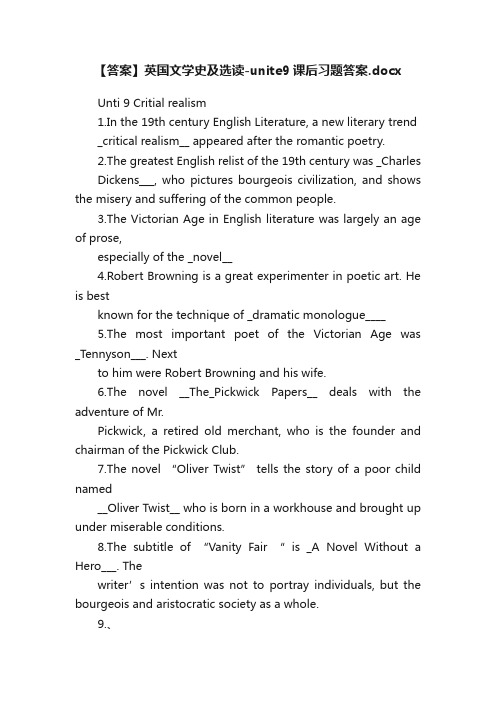
【答案】英国文学史及选读-unite9课后习题答案.docxUnti 9 Critial realism1.In the 19th century English Literature, a new literary trend_critical realism__ appeared after the romantic poetry.2.The greatest English relist of the 19th century was _CharlesDickens___, who pictures bourgeois civilization, and shows the misery and suffering of the common people.3.The Victorian Age in English literature was largely an age of prose,especially of the _novel__4.Robert Browning is a great experimenter in poetic art. He is bestknown for the technique of _dramatic monologue____5.The most important poet of the Victorian Age was _Tennyson___. Nextto him were Robert Browning and his wife.6.The novel __The_Pickwick Papers__ deals with the adventure of Mr.Pickwick, a retired old merchant, who is the founder and chairman of the Pickwick Club.7.The novel “Oliver Twist” tells the story of a poor child named__Oliver Twist__ who is born in a workhouse and brought up under miserable conditions.8.The subtitle of “Vanity Fair “ is _A Novel Without a Hero___. Thewriter’s intention was not to portray individuals, but the bourgeois and aristocratic society as a whole.9.、10.The main plot of “ Vanity Fair” centers on the story of two women:Amelia Sedley and _Rebecca Sharp___. Their character are in sharp contrast.11.Charlotte Bronte’s masterpiece is_Jane Eyre__.12.Emily Bronte’s masterpiece is _Wuthering Heights___.13.The author of the “Return of the Native “ is _T homas Hardy____.14.George Eliot produced three remarkable novels including “ AdamBede”, “The Mill on the Floss” and “___’15.Among Hardy’s novels, the best-known are ____ and the “Jude theObscure”.16._Oscar Wilde___ is the representative among the writers ofaestheticism and decadence. “ the Picture of Dorian Gray “ is a typical decadent novel written by him.17.It was while living in Italy that Robert Browning published hisfinest volume of poems_____.18.Although writing from different points of view and with differenttechnique, writers in the Victorian period shared one thing in common, that is they were all concerned about _C__A. the love story between the rich and the poor.、B. the techniques in writingC. the fate of the common peopleD. the future of their own country.19.The author of the work “Dombey and Son” is:A. Charles DicknesB. Henry JamesC. Robert BrowningD. Thackarary20.As a love story, Wuthering Heights is one of the most moving thepassion between ___ proves the most intense, the most beautiful and at the same time the most horrible.A. Hareton and Cathy$B. Heathcliff and CatherineC. Hareton and CatherineD. Heathcliff and Cathy21.Do you think, because I am poor, obscure, plain, and little,I amsoulless and heartless …and if god had gifted me with some beauty, and much wealth, I should have made it as hard for you to leave me, as it is now for me to leave you. The above passage is most probably taken from___.A. Great ExpectationsB. Wuthering HeightsC. Jane Eyre.D. Pride and Prejudice22.Most of Thomas Hardy’s novels are set in Wessex ___A. a crude region in England~B. comprehensive knowledgeC. a remote rural areaD. Hardy’s hometown23.Tess of the D’Urbervilles, one of Thomas Hardy’s best knownnovels ,portrays man as ____A. being hereditarily good or badB. being self-sufficientC. having no control over his own fateD. still retaining his own faith in a world of confusion.24.The success of Jane Eyre is not only because of its sharp criticismof the existing society, but also due to its introduction to the English novel the first ___ heroine.A. worker…B. peasantC. governessD. explorer25.How do you understand that Dickens is the greatest critical realistwriter of the Victorian Age26.How do you understand that Dickens is the greatest critical realistwriter of the Victorian Age27.Why is Jane Eyre a successful novel。
梁实秋林语堂
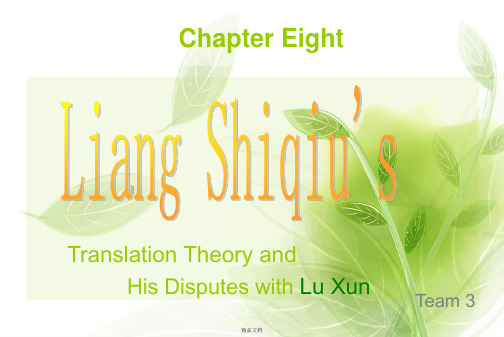
(gèrén)
台湾,任台湾师范学院英语系教授。1987年11
士比亚著,《暴风雨》(剧本)英国
月3日病逝于台北。
• 梁实秋40岁以后着力较多的是散文和翻译。散 文代表作《雅舍小品》从1949年起20多年共出 4辑。30年代开始翻译莎士比亚作品,持续40 载,到1970年完成《莎士比亚全集》的翻译, 计剧本37册,诗3册。晚年用7年时间完成百万
• From 1949 to 1966, he established himself as a lexicographer by bringing out a series of English-Chinese and Chinese-English dictionaries.
精品文档
翻译作品有《阿伯拉与哀绿绮斯的情
• 1929年9月梁实秋发表《论鲁迅先生的“硬译”》一文时,双方交战正值酣畅之际, 因而由此引发的翻译论战自然也就充满了刀光剑影。
• 与《论鲁迅先生的“硬译”》同刊发表的还有《文学是有阶级性的吗?》一文。针对 这两篇文章(wénzhāng),鲁迅写了《“硬译”与“文学的阶级性”》一文进行辩驳。他 首先质问梁实秋是否对《文艺与批评》一书“硬着头皮读下去”了,接着指出梁氏并 不能够代表“全国中的最优秀者”,他读不懂的译文,不见得别人也读不懂。尽管梁 实秋在《答鲁迅先生》一文中声称:“这两篇文章(wénzhāng)的本身,都是各自独 立的,毫无关系的。前一篇的主旨,是说明文学并无阶级的区别,后一篇的大意, 是指出鲁迅先生的几种翻译作品之令人难懂。”然而在把鲁迅的“硬译”贬为“死译”后 ,他又接着指出:鲁迅先生前些年翻译的文字还不是令人看不懂的东西,“但是最 近翻译的书似乎改变风格了。”
Chapter Eight
英国文学史及选读课件9TheVictoriaAg

总结词
讲述了吉卜赛弃儿希斯克利夫被山庄 老主人收养后所经历的爱情与复仇的 故事,展现了人性的复杂与矛盾。
详细描述
小说通过希斯克利夫的人生经历和爱 情故事,揭示了人性中的爱与恨、善 良与邪恶等复杂情感。作品语言独特 ,情节紧张,人物形象鲜明,具有很 高的艺术价值。
PART 04
维多利亚时期文学的影响 和意义
了工业革命后社会的变化。
浪漫主义时期文学
个性解放
强调个性的自由和情感的表达 ,反对工业化和城市化对人的 束缚。代表人物有威廉·布莱
克和约翰·济慈。
诗歌
以拜伦、雪莱和华兹华斯等为 代表的诗歌创作,表达了对自
然、自由和爱情的向往。
小说
以简·爱和呼啸山庄为代表, 关注人性的复杂性和情感的深
度。
维多利亚时期文学
维多利亚时期作家介绍
查尔斯·狄更斯
总结词
维多利亚时期最著名的作家之一,以其对社会问题的深刻洞察和生动描绘而著 称。
详细描述
狄更斯是19世纪英国文坛的巨匠,创作了多部经典小说,如《双城记》、《雾 都孤儿》和《大卫·科波菲尔》。他的作品揭示了社会不公和贫困问题,同时也 描绘了人性的复杂和多样。
勃朗特姐妹
托马斯·哈代
总结词
以描绘人物命运和社会现实而著称,作品具有强烈的悲剧色 彩。
详细描述
托马斯·哈代是维多利亚时期的一位重要作家,他的作品如《 德伯家的苔丝》和《无名的裘德》展示了其对人物命运和社 会现实的深刻洞察。他的小说常常以悲剧收场,反映了人生 的无常和社会的冷酷。
PART 03
维多利亚时期文学作品选 读
小说
出现了以《罗密欧与朱丽 叶》为代表的一系列悲剧 和喜剧作品,反映了当时 社会的矛盾和冲突。
